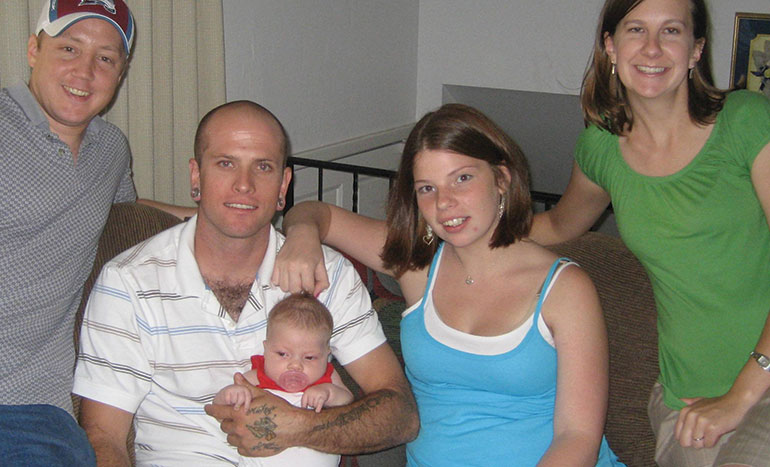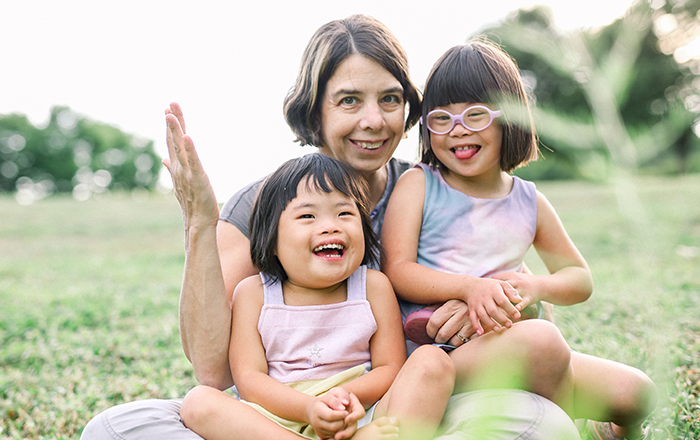They are the same in any adoption: excitement, nervous anticipation, overwhelming joy, and perhaps some moments of sadness. The emotions prompted by the process of adding to one’s family — whether at the hospital or the airport — are profound. But what happens when welcoming a new child means embracing a new family, too?
In an open adoption, those early days of getting to know a child often involve getting to know his birth mom, birth father, biological siblings, and maybe even a grandma or two. As their new “normal” unfolds over their first year together, families in open adoption experience a series of changes — many good, a few challenging — and they wouldn’t have it any other way.
In the stories that follow, four moms share memories of their first year in an open adoption. Whether they have almost no ongoing contact with the birth parents or their families regularly spend holidays together, these parents’ advice for navigating the first year will shed some light on the complex family structure that is open adoption.
The Bates Family: No Post-Adoption Contact
“At the end of each letter I send, I invite the birth mother to communicate.”
From the beginning, Tara Bates felt that divine providence played a role in the making of her family. She and her husband, Jamie, were considering international adoption when they gave in to her mom’s advice to call a local agency. “Three weeks later, we got a call saying that we had been matched,” says Bates.
“The birth mother, Amy*, couldn’t believe we wanted to name the baby Jordan. That was her favorite name,” she says, adding that Jordan, now 22 months, has the same middle name as her birth mother.
The Bates were at the hospital when their daughter was born. With no one to support her during the birth, the 19-year-old birth mother relied on them for strength. But Amy, who was already parenting another child, seemed “100 percent comfortable” with her decision not to parent Jordan. “I didn’t know whom to take care of — this teenager who’s giving me the biggest gift, or the baby. Amy looked at me, and said, ‘Go take care of your daughter,’” recalls Bates.
After connecting so intensely with the birth mother, Bates thought that adjusting to their agreed-upon, semi-open adoption would feel strange. In fact, they haven’t heard from Amy since they left the hospital.
“It could be that things hit her harder when she got home,” says Bates. “Still, I’m disappointed that there’s been nothing to let us know how she’s doing.” Explaining the absence of contact will be a challenge as Jordan gets older.
The Bates’ agency required a letter and at least six photos one month after placement, and again at two, three, and six months, then once a year from that point on. When Jordan turns 12, she can decide whether to continue sending the letters.
But for now, it’s Bates’ responsibility, and she takes it seriously. She tries to include the kind of details a mother might appreciate. In one, she told Amy about Jordan’s shoe addiction. “She’s not even two, and she has 20 pairs of shoes,” she laughs.
At the end of each letter, Bates invites Amy to communicate. “I write, ‘We’d love to hear from you,'” she says. “We always tell her how unbelievably blessed we are, and we thank her for the decision she made.”
The Naus Family: Occasional Text Messages & Photos
“We were thrilled by the frequent phone calls as the year began, but contact with the birth mother dropped off. We respond whenever we hear from her, and let her know she remains a part of our lives.”
Families often find that openness changes over time. When Denise Naus and her husband, Darren, were matched with a birth mother, their agency recommended sending photos and letters every two or three months for the first year. To their surprise and delight, the birth mother, Cathy*, said she wanted more contact than that — and they were happy to take their cues from her. “She chose us, so we felt it was up to her to ask for what she wanted,” the Alberta, Canada-based mom explains. They decided their relationship would be based on pictures and written updates, but they were comfortable giving Cathy their phone number, too.
“We were so excited whenever she called in the months following Amara’s birth. I didn’t expect that,” says Naus.
But after three months, the once-a-month phone calls became once-in-awhile calls, and then once-in-awhile texts. “It’s really frustrating,” says Naus. “I would love to be able to e-mail Cathy pictures or even be friends on Facebook, but she doesn’t have a computer. At one point, we even considered buying her a laptop.”
Without regular feedback, it is hard to know what to include in the packages. At one point, Cathy asked Naus about Amara’s weight and her favorite color. Another time, months went by before Cathy replied about a batch of photos, indicating which one was her favorite.
“Along with the good news, I tell Cathy about some of the things we struggle with,” such as Amara’s temper tantrums, says Naus. “There’s a part of me that doesn’t want her to think, ‘She’s the perfect baby. I should have kept her.’ If I say something negative, however, I put a positive spin on it. For example, ‘She’s having temper tantrums, but we can settle her easily.’”
“Sometimes I wonder whether Cathy still wants the updates,” says Naus. “I don’t know what stage of grief she’s in. Maybe she’s healing, maybe she doesn’t need the contact as much.” Despite her uncertainty, Naus remains committed to the promise she made to Cathy. Eventually, she plans to decrease the frequency of updates to two or three a year — but she doesn’t plan to stop. “I’ll send updates as long as I have information for her, until Amara’s grown up,” she says.
The Hanson Family: Increasing Contact with Two Birth Families
“Our open relationship with our younger child’s birth family inspired us to reach out to our older child’s birth mother for more contact.”
When two children are in the equation, open adoption arrangements are twice as complicated — and twice as rewarding. When Catherine Hanson and her husband, Derek, decided to adopt a second child, they knew that a close relationship with the birth parents was important to them. Contact with their son Nick’s birth mother had been limited to their sending photos and periodic phone calls, but they wanted greater openness with Lexi’s birth parents, Steve* and Anna*.
“What none of us expected was how naturally the relationship would blossom. Steve and Anna are people we probably wouldn’t have gotten to know otherwise,” she says, pointing to their love of rock concerts and their different religious beliefs. “But I think having the common bond of expecting Lexi helped us become extended family from the start.”
The closeness with Lexi’s birth parents helped the Hansons open up more contact with Nick’s birth mother, Brenda*. They speak on the phone at least once a month, and, this past year, she joined the Hansons for a get-together for the first time.
Nowhere is the melding of two (or more) families more evident than at a family birthday party. At one last year, the Hansons had 21 family members, including birth parents, birth siblings, birth grandparents, and members of the extended adoptive family.
With so much extended, and blended, family time, some snags are to be expected. “It’s always a little challenging to put adoptive and birth families together — balancing the fact that everyone has his or her own special role,” says Hanson.
The essence of an open adoption is its dynamism: Lives change, circumstances evolve, people move on. Birth parents experience job changes, breakups, new relationships. “When things were rough for Brenda, we didn’t hear as much. Now things have changed. She’s engaged, she’s doing well emotionally, so contact has increased,” says Hanson. They see a similar waxing and waning of contact with Lexi’s birth family.
But because of the commitments that each party makes to the relationship, families find their way. “It’s not always easy, and it’s not always perfect, but it’s definitely worth the work,” says Hanson.
The Garber-Walker Family: Frequent Visits…and Facebook
“We decided to let our open adoption relationship grow organically. In our case, that’s meant lots of face-to-face visits and continual contact online.”
Experts recommend making a plan for contact with the birth parents before a child is born. But sometimes the best plan is to have no plan. Just ask Jenn Garber, mom to Brynn, nine months old.
“We felt comfortable with Morgan from the get-go,” Garber says. “We just said, ‘Let’s play it by ear.’”
At first it was easy to let circumstance dictate their relationship: Morgan, who lives about an hour and a half from Jenn and her husband, Philip Walker, pumped her breast milk for Brynn.
As time went on, they all fell into a rhythm. Now, every four to six weeks, Garber and family and Morgan take turns visiting each other. They spend the day together, eating and playing with Brynn. Sometimes the birth grandparents join them, too.
Though such an arrangement may not be ideal for all families, Garber couldn’t be happier about the way it’s working for them. “We feel really fortunate because, in many ways, we feel we have the ideal open adoption. Our daughter’s birth parents are really nice people. It’s easy to call them family.”
Many in open adoptions rely on the Web to maintain closeness over long distances. Between visits, Garber and Morgan stay in touch through texting, e-mails, and Facebook. Recently, Morgan’s status mused about a possible move. This was news to Garber, who quickly saved as many picture of Morgan as she could find. Though Morgan’s thoughts were fleeting, it was a reminder that Facebook provides unprecedented access into each other’s lives, for better or worse.
For now, Garber can relax and enjoy having her daughter’s birth mother nearby. And in the future, if things change, the two families will adjust accordingly, tied together by an unbreakable bond.
*Names have been changed to protect privacy.



